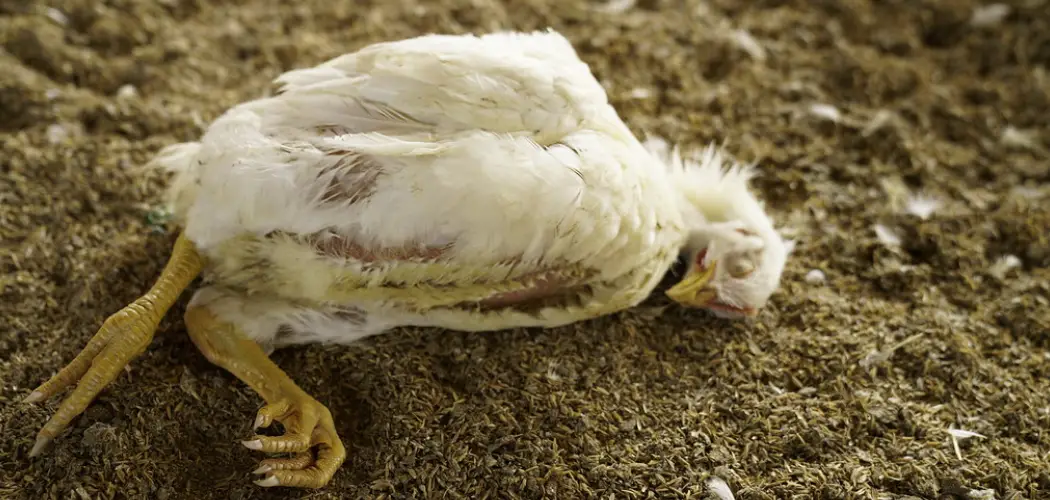Disposing of a deceased chicken is an inevitable and sensitive aspect of poultry keeping, requiring careful consideration and appropriate methods to ensure sanitation and environmental safety.
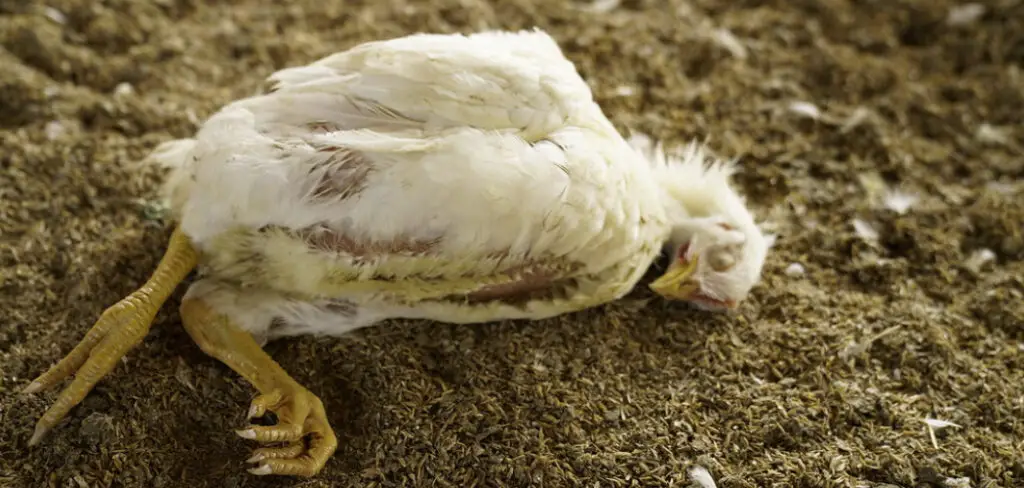
Whether due to illness, injury, or natural causes, the responsible handling of a dead chicken is essential to prevent the spread of disease and maintain the health of the flock. Understanding the proper disposal methods is not only a matter of biosecurity but also a respectful acknowledgment of the life once cared for.
In this guide, we will explore the considerations and techniques involved in how to dispose of a dead chicken, ranging from burial and composting to rendering and incineration. By following these guidelines and regulations, poultry keepers can navigate this challenging aspect of husbandry with compassion and responsibility, safeguarding both their flock and the surrounding environment.
Importance of Proper Disposal
Proper disposal of a dead chicken is crucial for several reasons. First and foremost, it helps prevent the spread of disease amongst the remaining flock as certain pathogens can be transmitted through the deceased animal. Secondly, it protects wild animals and pets from potential exposure to diseases.
Environmental protection is also a key consideration; improper disposal can lead to contamination of soil and water sources. Moreover, adhering to local regulations regarding the disposal of farm animals is necessary to avoid legal repercussions. Lastly, responsible disposal practices demonstrate respect for the animal and the farm’s role within the greater ecosystem.
Sensitivity and Responsibility in Handling Deceased Poultry
Handling deceased poultry with sensitivity and responsibility is an ethical obligation for every poultry keeper. It is essential to approach this task with a sense of duty and reverence for the life that has ended. Poultry keepers must act promptly to remove the carcass to minimize distress to the flock and reduce health risks.
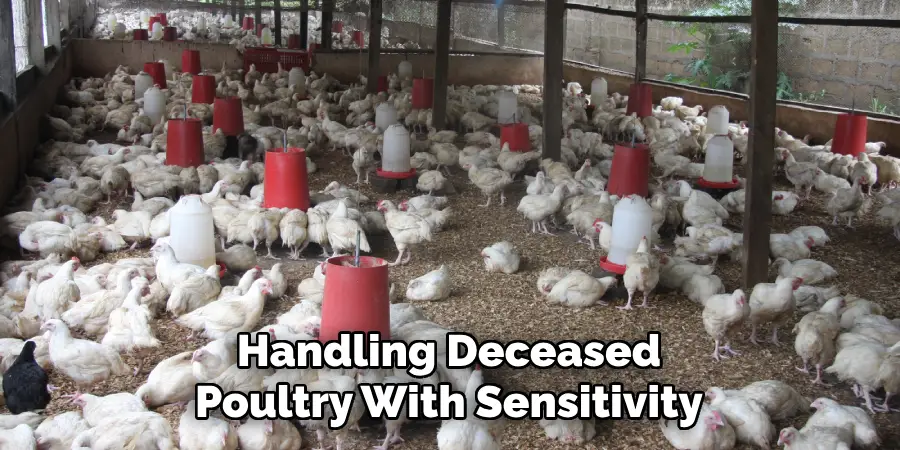
Protective gloves should be worn to prevent direct contact, and the carcass should be handled gently to honor the bird’s contribution to the farm. Furthermore, swift and considerate actions reflect the keeper’s commitment to the well-being of their poultry and the environment, upholding a standard of care that extends beyond the life of the animal.
Understanding Biosecurity Concerns
Biosecurity is a critical component in the management of poultry and involves preventative measures to reduce the risk of infectious diseases entering or spreading within a flock. When it comes to disposing of a dead chicken, biosecurity concerns are paramount.
Infectious agents can easily be transferred from the deceased animal to the living birds, to humans handling the birds, and even to other farms or wild populations. This risk necessitates strict protocols for carcass handling, including the use of protective gear, proper containment, and immediate disposal.
Adherence to biosecurity measures safeguards not only the current flock but also the broader agricultural and natural communities, thus playing a vital role in the overall health of domestic and wild animals.
Minimizing Environmental Contamination
The minimization of environmental contamination is a significant aspect of corpse disposal and biosecurity. Deceased chickens can harbour bacteria, viruses, and parasites that have the potential to leach into the soil and nearby water bodies.
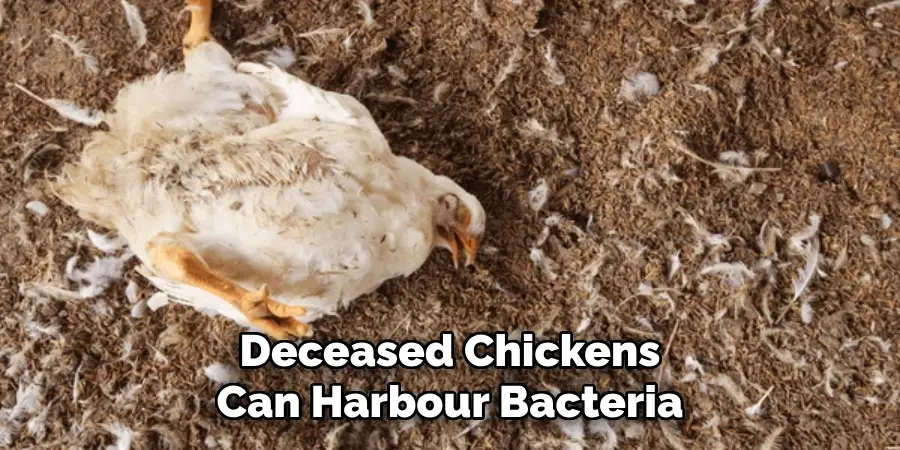
Such contamination can disrupt local ecosystems, affect plant life, and pose a risk to other wildlife as well as human health. Utilizing methods such as deep burial or incineration helps to restrict the entry of harmful pathogens into the environment.
Poultry keepers should be mindful of local water tables when choosing burial sites and consider the impact of their disposal choices on the surrounding flora and fauna. In essence, every effort must be made to contain and neutralize potential contaminants to uphold the integrity of the ecosystem.
Legal and Regulatory Considerations
When disposing of a dead chicken, it is imperative to be aware of and comply with local laws and regulations. Many jurisdictions have specific requirements for the disposal of livestock carcasses, which can include designated methods, permits for certain disposal types, and reporting procedures for cases of infectious disease or large-scale die-offs.
Failure to follow these regulations can result in fines or other legal penalties. It’s essential for poultry keepers to stay informed about their local regulations, which may vary depending on the region, type of poultry kept, and the number of animals.
Cooperation with agricultural extension services or local veterinary authorities can provide guidance and ensure that disposals are conducted within the legal framework, thus maintaining public health standards and community relations.
10 Methods How To Dispose of A Dead Chicken
Method 1: Burial
One of the most common and humane methods is burying the deceased chicken. Choose a suitable location away from water sources and at least three feet deep to prevent scavengers from digging it up. Place the chicken in a biodegradable material such as a cardboard box or shroud. Cover the grave with soil and mark it to avoid accidental disturbance.

Burying the chicken not only allows for a peaceful resting place but also helps return nutrients to the soil. If you have a garden or plants, you can even use the burial site as a compost area. This method is also more cost-effective and environmentally friendly compared to other methods such as cremation or using chemicals.
When burying a chicken, it’s important to follow local regulations and guidelines. Some areas may have restrictions on burying animals, so it’s best to check with your local authorities first.
Method 2: Composting
Composting is an eco-friendly way to dispose of a dead chicken. Create a compost pile in a designated area of your property. Layer the chicken with organic materials such as leaves, straw, and kitchen scraps. Turn the compost regularly to facilitate decomposition. Ensure the composting area is secure to prevent access by scavengers.
Composting is a natural process that recycles organic waste into nutrient-rich soil, known as compost. This compost can then be used in your garden to help plants grow healthier and stronger. Not only is composting beneficial for the environment, but it also saves money on fertilizers and reduces overall waste.
To start composting with a dead chicken, you will need a designated area for the compost pile. This can be a simple patch of ground, or you can purchase a compost bin to contain the materials. Make sure this area is easily accessible and convenient for adding organic materials.
Method 3: Incineration
Incineration involves burning the deceased chicken. Use a dedicated incinerator or a burn barrel in a well-ventilated area. Follow local regulations, and consider air quality and environmental impacts. Ensure complete combustion to minimize any potential odor or contaminants.
Take precautions to prevent the spread of diseases through airborne particles. It is also important to properly dispose of the ashes after incineration.
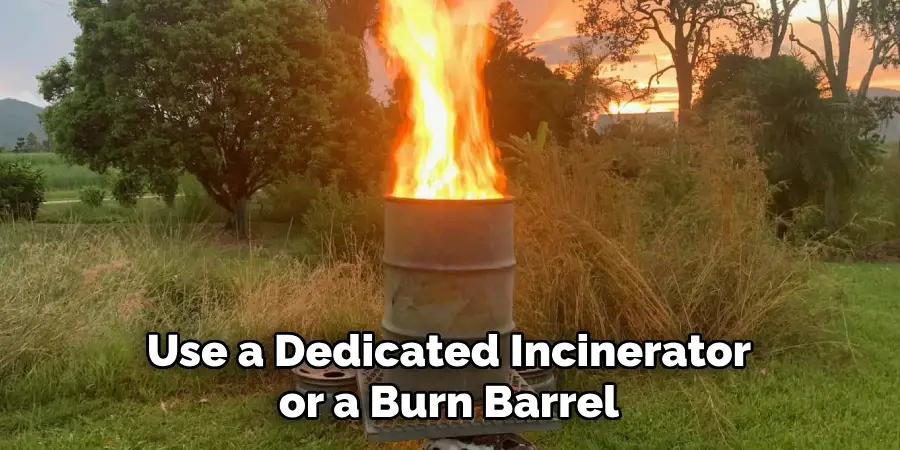
There are a few things to keep in mind when using this method. First, make sure to have proper ventilation and follow any regulations set by your local government. This is important for both air quality and potential environmental impacts.
In addition, be mindful of any potential odors or contaminants that may result from the burning process. To minimize these, it is crucial to ensure complete combustion during incineration.
Another important consideration is preventing the spread of diseases through airborne particles. This can be achieved by taking proper precautions, such as wearing protective gear and properly disposing of any remaining debris after incineration. It is also recommended to clean and disinfect the area afterwards to further reduce any potential risks.
Method 4: Rendering
Rendering is a process that converts animal remains into usable materials. While this method is more common in larger-scale operations, you can explore local rendering services. They may pick up the deceased chicken for processing into products such as pet food, bone meal, or biofuels. Rendering is an environmentally-friendly way to dispose of animal remains, as it repurposes these materials rather than sending them to a landfill. However, keep in mind that this method may not be available or accessible in all areas.
In addition to rendering being an eco-friendly option for chicken disposal, it also has various benefits such as reducing waste and preventing disease outbreaks. By converting the remains into usable materials, rendering helps reduce the amount of waste that goes to landfills, which can contribute to environmental pollution. It also prevents potential disease outbreaks by safely and efficiently disposing of animal carcasses.
Moreover, rendering can be a cost-effective option for chicken disposal as it often incurs lower costs compared to other methods such as cremation or burial. This is especially beneficial for larger operations, where the cost of disposing of multiple chickens can add up. Rendering also saves time and effort as the process is usually carried out by the rendering service, allowing you to focus on other tasks.
Method 5: Natural Predation
Allowing natural predation can be considered, especially if you have a larger property with wild animals. Place the deceased chicken in a secured location away from your living areas, ensuring it won’t attract predators close to your home. This method mimics nature’s cycle, but it’s important to consider local wildlife and safety concerns. If you live in an area with large predators, such as coyotes or bears, this may not be a safe option.
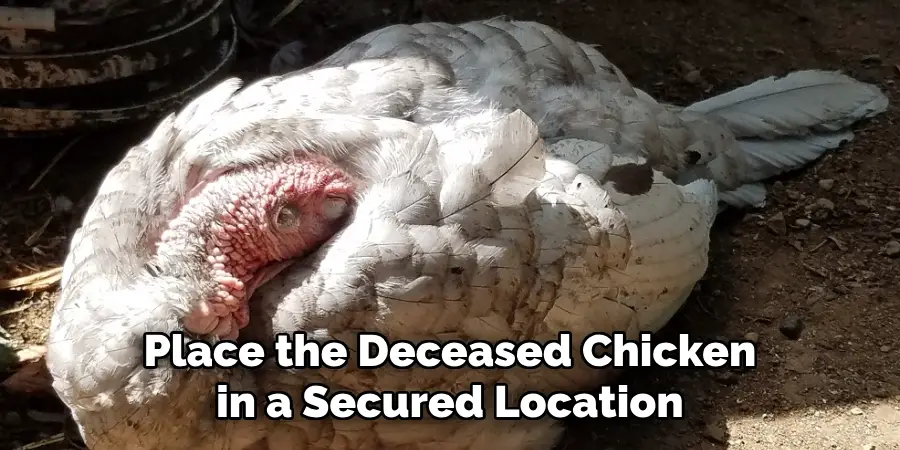
Additionally, if you have small children or pets, it’s important to keep them away from the carcass and the potential predators it may attract.
One way to safely implement natural predation is by using a chicken tractor. A chicken tractor is a portable coop that allows chickens to forage in a contained area while still being protected from predators.
Place the deceased chicken inside the fenced area of the chicken tractor and allow nature to take its course. This method not only mimics natural predation, but it also helps to fertilize your land as the chickens forage.
Another option is using live traps to catch and relocate potential predators. This can be a more labor-intensive method, but it allows for the safe removal of predators without harming them. It’s important to check local laws and regulations before trapping and relocating wildlife.
Method 6: Alkaline Hydrolysis
Alkaline hydrolysis, also known as liquid cremation, is an eco-friendly method gaining popularity. It involves submerging the deceased chicken in a water and alkali solution, accelerating decomposition. This method is more commonly used in industrial settings, but smaller-scale options may become available in the future.
Alkaline hydrolysis works by breaking down the chicken’s body tissues using a combination of water and alkali, such as potassium hydroxide or sodium hydroxide. The process is similar to what happens during natural decomposition, but at a much faster pace.
One of the main benefits of alkaline hydrolysis is its environmental impact. Unlike traditional burial which can use up valuable land resources and release harmful chemicals into the soil, alkaline hydrolysis does not produce any greenhouse gases or toxic substances. The remaining liquid is sterile and can be safely discharged into the sewage system.

Method 7: Donation to Wildlife Rehabilitation Centers
Check with local wildlife rehabilitation centers or raptor rehabilitation organizations if they accept deceased animals for educational purposes or as a food source for rehabilitating birds of prey. Ensure compliance with local regulations and guidelines when considering this option.
Donating deceased animals to wildlife rehabilitation centers is another way to give these animals a second chance at life. These centers are dedicated to rescuing, rehabilitating, and releasing injured or orphaned wildlife back into their natural habitats.
By donating deceased animals, you are providing a valuable food source for the birds of prey in the care of these centers. This helps to reduce costs for the organization and ensures that these animals are receiving a natural and nutritious diet.
Method 8: Freeze and Dispose with Regular Trash Collection
If none of the aforementioned methods are feasible, you can freeze the deceased chicken until your regular trash collection day. Wrap it securely in a sealed bag to prevent odor and leakage. Check with local authorities to confirm that this method aligns with waste disposal regulations.
This method may not be suitable for everyone, as it requires the availability of a freezer and may result in additional costs. Also, keep in mind that freezing a deceased chicken is not a long-term solution and should only be used if you are unable to bury or cremate the bird immediately.
If freezing is your chosen method, make sure to dispose of the frozen chicken on the day of your regular trash collection. Do not put it in a compost bin as it may contaminate the soil and pose a risk to other animals.
Method 9: Consult Local Authorities or Veterinary Services
Local authorities or veterinary services may provide guidance on legal and ethical disposal methods. Some areas have specific regulations to prevent the spread of diseases or environmental contamination. Consulting with professionals ensures compliance with local laws and ethical standards. Additionally, they may offer support and resources for the proper disposal of animal remains.
It is important to note that improper disposal of animal remains can have serious consequences. It not only poses health risks but also has potential legal implications. Therefore, seeking guidance from local authorities or veterinary services is crucial in ensuring the safe and appropriate disposal of animal remains.
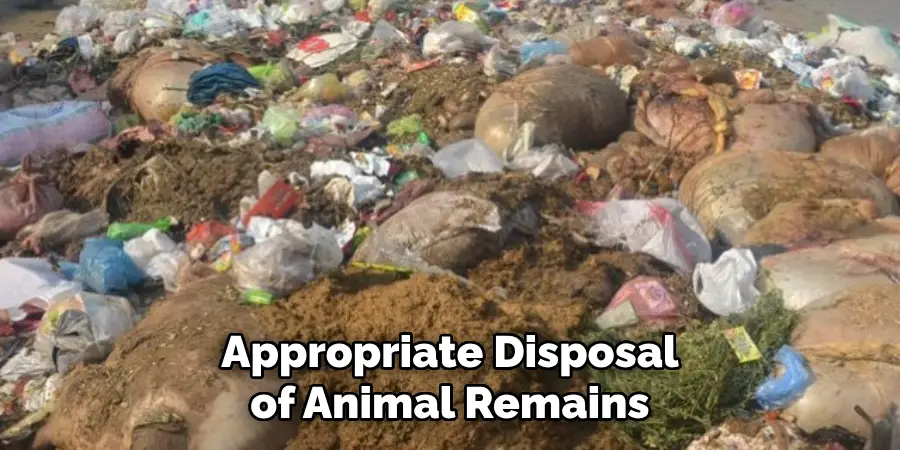
Some local authorities or veterinary services may also offer options for environmentally-friendly methods of disposal, such as cremation or composting. These methods not only address the ethical concerns of proper disposal but also contribute to reducing environmental impact.
Method 10: DIY Dehydration
For those seeking a unique alternative, DIY dehydration involves using a specially designed composting system that dehydrates organic matter. This method reduces the volume of the deceased chicken while producing compostable material. Research local regulations and follow safety guidelines when considering this approach.
The DIY dehydration method is not a common practice and requires some effort and investment. However, it can be a more eco-friendly option for those who are environmentally conscious. This method uses heat to dry out the organic matter of the deceased chicken, resulting in a reduced volume of waste.
To start with, you will need to construct or purchase a specialized composting system that has the ability to dehydrate organic matter. These systems can be found online or at local farming supply stores. Once you have the system, follow the instructions carefully and set it up in a designated area.
Conclusion
In conclusion, when faced with the unfortunate task of disposing of a dead chicken, it is essential to approach the process with sensitivity, ethics, and adherence to local regulations. The methods mentioned, from traditional burial and composting to more innovative approaches like alkaline hydrolysis or donation to wildlife centers, offer a range of choices depending on individual circumstances.
Always prioritize the well-being of your local environment, the safety of other animals, and compliance with legal requirements. Additionally, considering methods that contribute positively, such as donation for educational purposes, can provide an opportunity to give purpose even in the face of loss. Thanks for reading, and we hope this has given you some inspiration on how to dispose of a dead chicken!
About
Outdoor Fixes is a distinguished figure in the world of Diy design, with a decade of expertise creating innovative and sustainable Diy solutions.
His professional focus lies in merging traditional craftsmanship with modern manufacturing techniques,
fostering designs that are both practical and environmentally conscious. As the author of diy,
outdoorfixes delves into the art and science of outdoorfixes-making, inspiring artisans and industry professionals alike.
Education RMIT University
(Melbourne, Australia) Associate Degree in Design (Outdoor Fixes) Focus on sustainable design, industry-driven projects,
and practical craftsmanship. Gained hands-on experience with traditional and digital manufacturing tools, such as CAD and CNC software.
Nottingham Trent University
(United Kingdom) Bachelor’s in outdoorfixes.com and Product Design (Honors) Specialized in product design with a focus on blending creativity with production
techniques. Participated in industry projects, working with companies like John Lewis and Vitsoe to gain real-world insights.
Publications and Impact
In diy, Outdoor Fixes his insights on indoor design processes, materials, and strategies for efficient production.
His writing bridges the gap between artisan knowledge and modern industry needs, making it a must-read for both budding designers and seasoned professionals.

